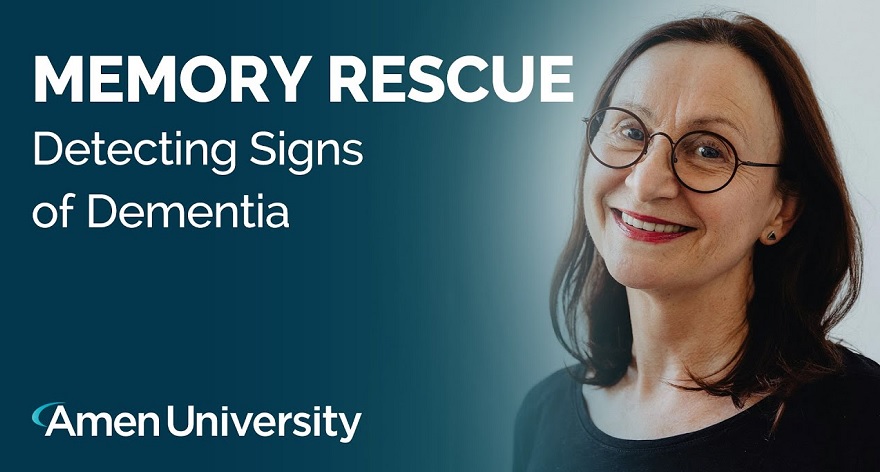
Misplaced keys, forgotten names, walking into a room and wondering why you are there, these moments can be mildly amusing at first. Over time, they can become unsettling, especially if there is a family history of dementia or you have watched a loved one struggle with memory loss. Many people worry about their memory long before they receive any formal diagnosis.
Dr Daniel Amen’s Memory Rescue course was created for that gap. It is aimed at people who want to understand why memory problems appear, what puts the brain at risk, and which day to day habits actually help. Instead of vague advice to stay mentally active, the course lays out a structured plan for identifying brain risks and building a routine that supports memory, attention, and long term brain health.
Contents
What The Memory Rescue Course Is Designed To Do
The program is built around a simple but ambitious goal, to help you rescue your memory by rescuing your brain. That means looking beyond crossword puzzles and focusing on the underlying organ. The course teaches you to identify risk factors that harm the brain, strengthen areas that are struggling, and support loved ones who may already be dealing with cognitive decline.
Who The Course Is For
Memory Rescue is designed for several groups:
- Adults in midlife who notice more forgetfulness and want to stay sharp at work and home.
- Older adults who want to protect memory and slow further decline.
- Family members caring for someone with mild cognitive impairment or dementia.
- Health and wellness professionals who want a clear brain based framework to share with clients.
You do not need a medical background to follow the material. The teaching is aimed at motivated laypeople, with enough depth that professionals can still find it useful.
Education Alongside Medical Care
The course is educational, not diagnostic. It does not replace seeing a doctor, neurologist, or other clinician if you are worried about more than ordinary forgetfulness. Instead, it gives you language and practical steps to bring to those appointments and to combine with medical care. Repeated reminders throughout the material encourage you to work with a health professional when you face significant cognitive changes or serious medical conditions.
How The Memory Rescue Course Is Structured
The course is organized into a series of online video lessons with accompanying worksheets and downloads. The content follows the structure of Dr Amen’s Memory Rescue book, but expands it with demonstrations, case examples, and step by step guidance.
Modules That Build A Complete Plan
Lessons are divided into modules that address key phases of the Memory Rescue process. Typical themes include:
- Understanding how memory works and why it fails.
- Learning the major brain risk factors that damage memory.
- Identifying your own risk profile using checklists and questionnaires.
- Building a personalized plan to reduce risks and strengthen the brain.
- Supporting loved ones who are already facing memory problems.
Each module includes several short videos rather than long lectures, which makes it easier to watch and rewatch content even if your attention span feels strained.
Tools, Checklists, And Progress Tracking
Beyond videos, the course provides practical tools. You get printable checklists for risk factors, planning sheets for nutrition and lifestyle changes, and simple tracking forms for sleep, exercise, and brain supporting habits. These tools are meant to turn the Memory Rescue concept into a working plan, not just an interesting idea.
By tracking what you change and how you feel, you can see which parts of the plan make the most difference in your own life, rather than guessing based on general advice.
The Memory Rescue Framework: BRIGHT MINDS
At the core of the course is a framework that organizes brain risks into clear categories. Dr Amen often uses the acronym BRIGHT MINDS to help students remember the main contributors to brain aging and memory problems. Each letter stands for a risk area, such as blood flow, retirement and aging, inflammation, genetics, head trauma, toxins, mental health, immunity and infections, neurohormones, diabetes and obesity, and sleep.
From Scattered Risks To A Structured Map
Instead of treating each risk factor as a separate project, the Memory Rescue course shows you how they fit together. For example, poor sleep can worsen blood flow and inflammation, which in turn affect mood and memory. Diabetes affects blood vessels and brain energy. Head injuries and toxins can weaken specific brain regions.
By mapping your life onto the BRIGHT MINDS framework, you can see where your own biggest threats are and which changes will protect the most brain function for your effort.
Identifying Your Top Risk Factors
The course guides you through self assessments that highlight areas of concern. You might discover that your main risks include untreated sleep apnea, a history of concussions, heavy sugar intake, and high stress, while someone else’s list centers on hypertension, family history, and sedentary habits.
This personalized risk profile is the foundation of the plan. It keeps you from wasting energy on changes that matter little while ignoring ones that matter a lot.
Key Strategies The Course Teaches For Fighting Forgetfulness
Once you understand your risks, the Memory Rescue program moves into specific strategies. These strategies combine lifestyle adjustments, cognitive habits, and environmental changes.
Protecting Brain Blood Flow
Healthy blood flow is crucial for memory. The course explains how conditions such as untreated high blood pressure, smoking, lack of activity, and certain medications can reduce blood flow to the brain. It then offers ways to work with your doctor to address vascular issues and to use daily habits, such as regular physical activity and targeted nutrition, to support circulation.
Even simple steps, like consistent walking, managing blood pressure, and avoiding nicotine, are presented as powerful tools for protecting memory.
Reducing Inflammation And Oxidative Stress
Chronic inflammation and oxidative stress can damage brain cells over time. The course covers how diet, sleep, stress, infections, and environmental exposures contribute to inflammation. Practical guidance includes shifting toward more whole foods, plenty of colorful vegetables, adequate omega 3 fats, and fewer highly processed foods.
Where appropriate, the material discusses common laboratory tests that clinicians use to look at inflammatory markers, always with the reminder to consult your own healthcare provider before pursuing extensive testing.
Repairing And Supporting Brain Chemistry
Memory does not operate in isolation. Mood, focus, and energy all influence how well you encode and recall information. The course explain how depression, anxiety, chronic stress, and hormone imbalances can interfere with memory, and encourages you to address these issues as part of your rescue plan.
Strategies include stress management techniques, sleep routines, and working with professionals to evaluate mood and hormone concerns rather than accepting them as normal aging.
Training Memory With Everyday Habits
Alongside medical and lifestyle strategies, the program teaches direct memory training skills. These include techniques for paying attention more effectively, using association and visualization, organizing information, and creating routines that reduce the burden on working memory, such as keeping important items in consistent places and using external reminders.
The focus is on practical habits that can be woven into daily life, rather than abstract brain games that never leave the screen.
Supporting Loved Ones With Cognitive Challenges
A significant part of the Memory Rescue course is devoted to caregivers. Watching a spouse, parent, or friend forget names, lose track of conversations, or get lost in familiar places can be painful and frightening. The course offers both education and empathy for this role.
Understanding What Loved Ones Are Facing
The material explains in simple terms what is happening in the brains of people with mild cognitive impairment, Alzheimer’s disease, or other dementias, and why certain behaviors appear. This understanding can reduce frustration and misinterpretation. Instead of seeing repeated questions as stubbornness, caregivers can see them as the result of damaged memory circuits.
That shift does not remove the burden, but it can soften some of the emotional strain and guide more patient communication.
Creating A Brain Friendly Environment
Caregivers also learn how to adjust the home environment to support memory and safety, such as using labels, simplifying choices, controlling noise and clutter, and structuring routines. Small changes, like clear lighting, consistent layouts, and predictable daily schedules, can reduce confusion and agitation.
The course emphasizes that caregivers must also protect their own brains. Chronic stress, lack of sleep, and constant vigilance can harm their health if they do not build in support and respite.
Where The Course Fits In A Larger Brain Health Plan
Memory Rescue is most powerful when it is part of a broader brain health plan rather than a standalone project. The course can give you a structured roadmap, but real progress depends on steady application and collaboration with healthcare providers.
For many people, the program works best as a bridge between concern and action. It moves you from vague worry about getting older or repeating family patterns into clear steps that you can measure. Even if you cannot control every risk, you gain more influence over how your brain ages than you might have assumed.
Used in this way, Dr Amen’s Memory Rescue course becomes more than a set of videos. It can become the backbone of a plan to fight forgetfulness, sharpen your thinking, and support the people you love as all of your brains grow older together.

